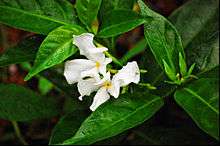Conolidine
 | |
| Identifiers | |
|---|---|
| 100414-81-1 | |
| ChemSpider | 26000837 |
| Jmol interactive 3D | Image |
| PubChem | 51051652 |
| |
| |
| Properties | |
| C17H18N2O | |
| Molar mass | 266.34 g·mol−1 |
| Except where otherwise noted, data are given for materials in their standard state (at 25 °C [77 °F], 100 kPa). | |
| | |
| Infobox references | |

Conolidine is an alkaloid. Preliminary reports suggest that it could provide analgesic effects with few of the detrimental side-effects associated with opioids such as morphine, though at present it has only been evaluated in mouse models.
Conolidine was first isolated in 2004 from the bark of the Tabernaemontana divaricata (Crepe jasmine) shrub which is used in traditional Chinese medicine.[1]
A method for creating synthetic conolidine from a commercially available acetyl-pyridine in 9 steps was developed by Micalizio, Bohn, and coworkers in 2011.[2] This synthetic route allows access to either enantiomer (mirror image) of conolidine via an early enzymatic resolution. Notably, both enantiomers of the synthetic compound show analgesic effects.[3]
See also
References
- ↑ Kam, T.-S.; Pang, H. S.; Choo, Y. M.; Komiyama, K. (Apr 2004). "Biologically Active Ibogan and Vallesamine Derivatives from Tabernaemontana divaricata". Chemistry & Biodiversity 1 (4): 646–656. doi:10.1002/cbdv.200490056. PMID 17191876.
- ↑ Tarselli, M. A.; Raehal, K. M.; Brasher, A. K.; Groer, C.; Cameron, M. D.; Bohn, L. M.; Micalizio, G. C. (2011). "Synthesis of Conolidine, a Potent Non-Opioid Analgesic for Tonic and Persistent Pain". Nature Chemistry 3 (6): 449–453. doi:10.1038/nchem.1050. PMID 21602859.
- ↑ Ball, P. (May 2011). "Compound Offers Pain Relief Without the Complications". Nature. doi:10.1038/news.2011.313.